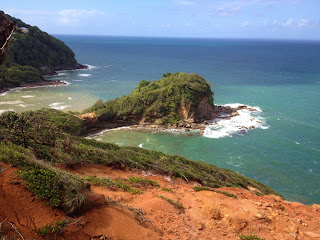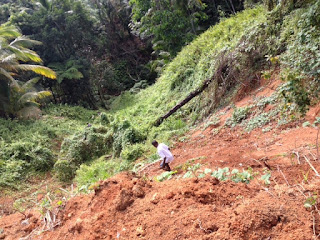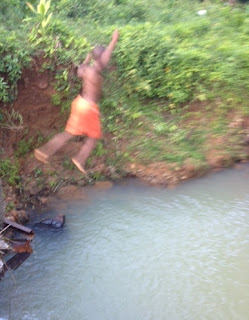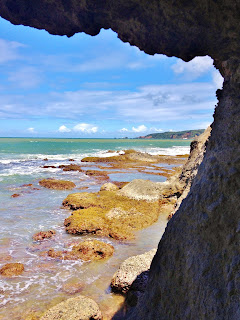Thursday, March 31, 2016
My Indiana Jones Day
Wednesday, March 23, 2016
Morne Rouge
Friday, March 18, 2016
Always an Adventure!
I only taught at school on Monday and Tuesday, because I had to spend the last three days of this week in training at the Peace Corps office in Roseau. On Tuesday afternoon and evening, we had some torrential downpours, which led to some localized flooding. Below is an example, looking downstream from the Church Street bridge. This is normally a very small, calm brook, but Tuesday was the worst I had seen it since Tropical Storm Erika.
I woke up early on Wednesday morning, so I could catch the first bus to the capital a little after 6:00 AM. In the hazy gray dawn after all that rain, our bus came around a curve and found a boulder in the middle of the road (see picture below). Luckily, there is a little shop (just out of view on the left side) that has a paved parking area along this section of the road. That parking area allowed enough room for vehicles to squeeze around the left side of the rock. [By the way, this picture was taken on the way home Wednesday evening, and someone had tried to paint the rock red as a warning to drivers.] Further up the road, as it climbs towards the crest that separates the Atlantic watershed from the Caribbean watershed, we came around another curve to find a new landslide nearly blocking the roadway. Needless to say, Wednesday morning wasn't the normal commute to the capital. Since my first day of this three day training session was so memorable because of the surprises on the bus ride, it was only fitting that the final day of this week would also be memorable. Our training finished in time today for me to make my way over to where the buses bound for the north of the island depart. My favorite evening bus driver was still there, so I was able to grab one of the last seats before he left.However, we were only a bit past halfway home when he pulled the bus over because it was overheating. As shown below, with these vans that have a cab-forward design, the engine compartment is accessed from the inside. I took the opportunity to get out of the bus and wander around.
It just so happened that our bus had stopped near a spot that had been in the news this week. During Tropical Storm Erika, a number of slides had occurred along the main road which connects Dominica's two largest cities (Roseau and Portsmouth), and runs along the western side of the island. With most of these slides, all that was done was to put up some barrels to warn drivers to swing wide around these dangerous spots. However, this week's rain had caused one of these slips to get worse, as portions of the roadway (including the warning barrels) fell down this hillside. Our bus broke down at this spot, allowing me to take the picture above. You may notice the late afternoon sun gave me a shadow towards the left side that makes me seem very tall. I was cautious as to how close I stood to the precipice, because I didn't want to cause any further landslides! If you look carefully, you can see our bus in the distance (along with some of the passengers in the shade to the right). If you look down the hill, you can also see the old maroon-and-white warning barrels that fell into the ravine during the most recent cave-in of the hillside. On the opposite side of the slip, you can see some black utility pipes that were severed when the embankment slid down the hill. Perhaps that was carrying the fiber optic cabling for internet access, or perhaps they were water pipes. Regardless of what they carried originally, they are not able to carry anything any more.So that is what led to my brief conversation I mentioned at the start of this story (with the guy from my village) as we once again found ourselves stranded on this major road. Serving in the Peace Corps is an adventure, and sometimes these adventures are simply having a bus break down near an unusual spot along the drive home.
Eventually I was able to get a ride on another bus to Portsmouth. Then I had to wait for yet another bus to transport me to my village. Instead of an hour and a half commute, it was a little more than a two and a half hour commute. Fortunately, I didn't have any commitments tonight, and so I just relaxed and made the most of it. Such is life in the Peace Corps!
P.S. On Wednesday, there was also a French competition on the island, and our combined 4th and 5th grade class got to come with two of our teachers to the capital (fortunately, I have never had to teach French!). I was able to hook up with them after my training class was over. We took them to a local pizza parlor, and then to an ice cream shop before we boarded a bus back to our town. I'm very glad that I was able to join them! Below is a picture of all of us taken by one of my Peace Corps colleagues, whose school also was celebrating with pizza after the competition. [I'm glad that today's bus break-down didn't occur the night we were taking all the students home.]
Tuesday, March 15, 2016
Coffee Talk
Having avowed never to become a coffee drinker, I've saved a lot of money over the years—especially after Starbucks came along, bringing with it the era of expensive coffee. It isn't that I purposely avoid caffeine. It is just that I would typically drink tea or a Diet Mountain Dew instead of hot coffee if I need a “pick-me-up” in the morning.
However, I was intrigued when one of my students showed me an actual coffee tree in my village. There are several in our area, but one in particular (pictured above) is easily accessed along the road near the spring. The appearance of the coffee beans reminded me of cherries. If you want a “pick-me-up,” you can eat the fruit from the tree. There is a large green seed inside (see below), which is what produces the coffee most of you drink. But there is a thin layer of “meat” around the seed. The meat tastes to me a bit like a hard, thin, grape, but with a wood-like flavor. I was told that at one time, a lot of coffee was grown on this island. Some folks will still pick and fix it the old-fashioned way, letting the seeds dry in the sun, roasting them, and then grinding them up. If I'm offered a cup of labor-intensive, locally grown, harvested, and processed coffee, I will gladly give it a try. Just don't expect me to make it a habit.

















































